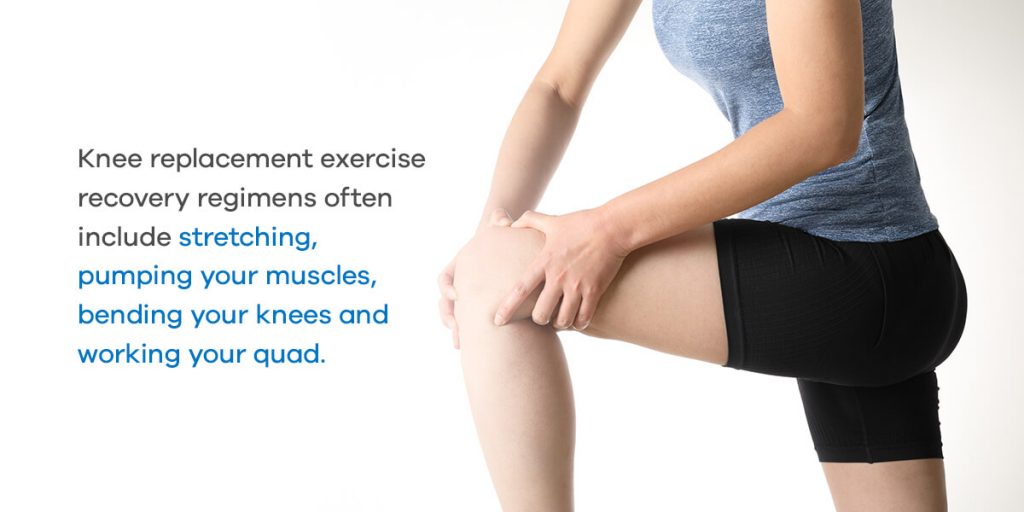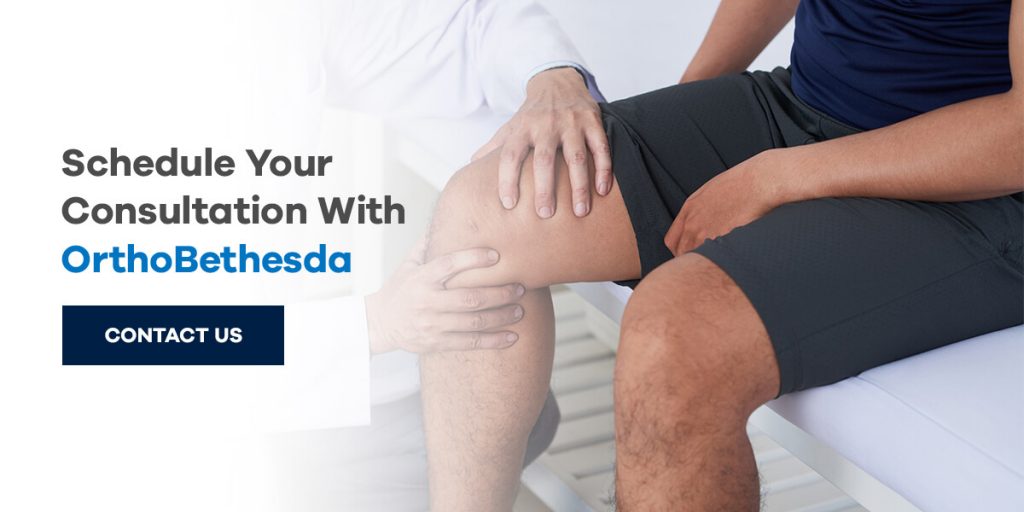
After undergoing a knee replacement surgery, it’s normal to want to get back on your feet as fast as possible. Regular exercise can help restore your strength and improve your range of motion so you can return to the everyday activities you love. At the same time, too much strain on your healing knee can cause post-operative swelling and pain.
Wondering how far to walk after knee replacement? This guide will help you navigate what to expect.
Knee Replacement Recovery Timeline
With knee replacement recovery times, most patients want to know how long after a knee replacement they can walk. Overall, full recoveries from knee replacements take six months to one year.
The most important healing with replacement surgery occurs within the first six weeks. As such, that period in the recovery timeline requires plenty of rest and care for your knee. At the same time, walking specific distances with assistance is necessary during those six weeks to keep blood flowing and accelerate healing.
Most patients are discharged one to two days after surgery, except in cases where there is a medical concern. Your surgeon will want to ensure your pain is controlled and you can perform basic tasks with minimal assistance before discharging you.
The first walk after surgery occurs within hours of waking from the procedure. This first walk will involve assistance from nurses and a walking device and may only be from your medical bed to the bathroom. During your stay in the hospital, the medical staff will focus on:
- Pain management
- Monitoring and preventing signs of complications
- Providing guidance on using assistive walking devices and performing basic tasks to prepare you for discharge
On your discharge day, you may be able to stand and walk out of your hospital room, or you may need assistance, which is completely normal. In the weeks following, most patients gradually expand their physical abilities. Every case is unique. Your surgeon and physical therapist will coordinate to progress you as quickly as possible.
Although everyone progresses at a different pace based on numerous factors, some common time frames are:
- Discharge to three weeks after surgery: Your doctor will encourage you to walk often with your crutches, walker or other assistive device and rest with your leg elevated above the heart to reduce swelling and pain. They will also give you exercises to do at home that strengthen and improve the flexibility of your calf, hamstring and quadricep muscles. The goal with exercises at this stage is to get your knee to the point where you can bend it at least 120 degrees. That flexibility level allows you to get in and out of car seats, chairs and sofas.
- Four to six weeks after surgery: Within four to six weeks of your surgery, you will likely be able to walk 10 minutes or more at a time without a walker, cane, crutches or other assistive device. Your physical therapist will encourage you to walk longer distances without an assistive device. You may be able to start driving again at this stage in your recovery if your doctor clears you.
- Eight to 12 weeks after surgery: Typical physical therapy programs last for eight to 12 weeks. At this point, you should be able to walk several blocks at a time and may even be able to pick up hobbies like swimming and cycling. After eight weeks, your doctor may permit you to perform modified activities that involve minimal knee twisting, like golf, dancing or yoga. After your therapy program ends around the 12-week mark, stick with your walking schedule and gradually challenge yourself to walk increased distances and durations.
- One year after surgery: You will continue to make progress for an entire year after knee replacement. By this time, your knee should reach its full strength, and you should be able to return to most activities, though you may notice additional improvements for up to two years after knee replacement surgery.
Recommended Exercises After Knee Replacement Surgery
After your knee replacement, it’s important to stick with the recommended physical therapy plan and continue challenging yourself without overexerting your healing knee. Following an exercise regime can also reduce swelling, increase your range of motion and strengthen your body. Knee replacement exercise recovery regimens often include stretching, pumping your muscles, bending your knees and working your quad.

One of the most highly recommended exercises is walking. Walking throughout your day will help you regain independence. Once you leave the hospital, try walking around your home using crutches, a walker or a cane as prescribed by your doctor or therapist. Use a heel-toe pattern to keep you from walking with a limp. Over time, you can increase your distance and level of effort until you can walk without any discomfort or limitations.
Some other beneficial exercises to try after knee replacement include:
- Ankle pumps: An ankle pump exercise stretches and strengthens your calf and ankle muscles while reducing post-surgical swelling, improving circulation and preventing blood clots. To perform an ankle pump, lie on your back with your leg extended and ankle supported by a rolled towel or blanket. Flex your foot by pushing your heel away from your body and pointing your toes upward. Hold for five seconds, then point your toes down and move your heel toward your calf. Hold for another five seconds and repeat as much as is comfortable.
- Heel slides: Heel slides engage your quadricep and gluteal muscles and increase the range of motion to your knee, improving flexibility and mobility. To do heel slides, you’ll lie on your back on a bed while extending your legs. Then, you’ll flex your hip and knee by moving the knee off the edge of the bed and sliding your foot along the bed while keeping your other leg straight, holding your position for 10 seconds.
- Knee extensions: Knee extensions strengthen your quads and improve knee flexibility and mobility. To perform a knee extension, sit upright in a chair and raise your foot while extending your knee until your leg is straight. Hold that position for five seconds, then slowly lower the foot until it touches the floor.
- Leg raises: Leg raises strengthen your gluteal muscles in your hip and quad muscles above your knee. This exercise strengthens the muscles that support your knee when you walk. Lie on your back on your bed with your unoperated knee bent and your foot touching the bed. Once you’re in that position, straighten your other leg so it’s flat against the bed. Then, lift the straightened leg with your toes pointing upward before gently lowering it back to the bed.
- Quad squeezes: As your quad muscles support and control your knee joint mobility, exercises that strengthen those muscles improve knee function. Quad squeezes do so without putting strain on your knee. To do a quad squeeze, lie on your back with your legs extended. Tighten your quad muscles by pushing the back of your knee to the bed, holding for 10 seconds.
Exercise Limitations After a Knee Replacement
Can you walk too much after knee replacement surgery? Like any activity, moderation is key. While walking is generally a highly recommended post-surgery activity, your excitement to get moving should be balanced with a respect for your healing body.
What is an optimal amount of walking after knee replacement surgery? Most physical therapists recommend walking as much as you find comfortable. Start with small, manageable steps over short distances and use an assistive device whenever needed. Gradually work your way up until you can walk longer distances without discomfort. Doing too much exercise can lead to pain and swelling, hindering your recovery.
Some other tips on what to do and what not to do after knee replacement surgery include:
- Avoid running or jumping until your knee is fully healed.
- Perform exercises in water or go swimming.
- Avoid high-impact sports involving quickly changing directions.
- Try cycling once you can walk without assistance — recumbent bikes are a great option.
- Avoid walking on rough, uneven surfaces right after surgery — use a treadmill instead.
- Ease into strength training.
- Avoid exercises or activities with a high risk of falling.
Knee Replacement FAQ
Understandably, patients generally have numerous questions about what to expect after a knee replacement procedure. Below, you’ll find some commonly asked questions about knee replacement recovery and restrictions.
Are There Any Permanent Restrictions After a Knee Replacement?
Although it is possible to participate in high-impact sports after a knee replacement, surgeons usually strongly discourage doing so even after the knee is fully healed.
Furthermore, patients with knee restrictions often have permanent work restrictions — medical instruction against performing certain activities at work — after having knee replacement surgery. Employers are legally obligated to honor those restrictions, which often occur even after patients have resumed normal activity levels.
That said, knee replacement surgery involves very few long-term limitations for patients. Besides high-impact sports, long-distance running and some work-specific activities, you should be able to resume your life with the freedom to participate in a broad range of activities after knee replacement surgery. The main reason for activity restrictions is to ensure a long knee replacement life span.
How Long Should You Do Exercises After Knee Replacement?
Most orthopedic surgeons and physical therapists recommend exercising for at least 20 to 30 minutes daily, whether it’s walking or stretching. As you progress through your recovery timeline and your knee gains strength, you can try walking or stretching for 20 to 30 minutes at a time multiple times a day.
Can You Overdo It After Knee Surgery?
As with any surgery, it is possible to overdo it after knee replacement surgery. For this reason, closely adhering to your doctor’s aftercare instructions for knee replacement surgery is essential. If you follow their instructions, you should have no worries about overdoing it after knee replacement surgery.
How Long Does It Take to Walk After a Full Knee Replacement?
In most cases, patients can walk without help from assistive devices like crutches or a walker within six weeks after knee replacement surgery. That said, physical therapy continues after this time to help your knee and the surrounding muscles grow stronger and more flexible.
Schedule Your Consultation With OrthoBethesda
Are you considering knee replacement surgery for yourself or a loved one? We know the questions and concerns can be daunting. OrthoBethesda is here to help. We specialize in orthopedic care, including surgical consultation, treatment, and pre-op / post-operative physical therapy. Our team of medical professionals and PTs can walk you through every step of your recovery. Book your consultation appointment today.

Related Content
- How to Know If You Tore Your ACL
- How to Prevent ACL Injuries
- Top 7 Stretches to Relieve Knee Pain for Athletes
- Why Knee and Joint Pain Increase When It’s Cold
- Why Your Knee Hurts When You’re Sitting
- How to Lose Weight With Knee Pain
- Is Walking Good for Arthritis in the Knee?
- Bilateral Knee Replacement Recovery Tips
- Robotic vs. Traditional Knee Replacement Surgery
- Best Positions to Sleep in After a Knee Replacement
- Stiffness After Knee Replacement Surgery
- What to Avoid After Knee Replacement
- Is There a Best Time of the Year to Schedule Knee Surgery?
- What to Expect After a Total Knee Replacement
- What to Expect After Arthroscopic Knee Surgery
- How Long Does It Take for a Torn Meniscus to Heal Without Surgery?
